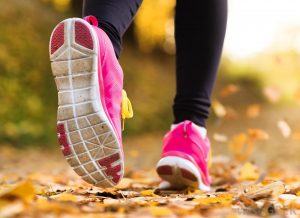For safety, make sure someone is with you when you complete this evaluation.
- For an exact distance, use a track or a measured and marked flat trail with a smooth surface. A standard track is 1⁄ mile, so you will walk four laps in the inside lane for the 1-mile evaluation. Otherwise, use a measured path, a street you have measured with the odometer on your car, or a treadmill, all of which may be less accurate but close enough.
- Warm up for several minutes with easy walking until your body feels warmer, then stretch.
- Get ready to start your mile walk. tips: try to walk a pace that’s steady but feels as if you’re pushing hard. remember, you’ll probably walk at least 11 to 1 minutes, so don’t start too fast. Pick up the pace in the last couple of minutes or last lap if you feel strong, which you should if you don’t start too fast.
- Your goal is to feel tired but not exhausted. You should feel slightly winded, but you should not gasp and pant.
- Cool down by continuing to walk slowly for a few minutes after you are done.
- Compare your time to the chart to assess your classification.

Figure 1 1-Mile Walking test.
Your brain hits the panic button, and that dumps waste products such as lactic acid into your system, which causes the burning, heavy, exhausted sensation in your body that forces you to slow or stop. As you train harder, the threshold moves higher, meaning you’ll be able to go faster longer before your body starts producing lactic acid. If you aren’t limited by technique at your top speed, you may find your legs starting to feel heavy, and that feeling is one unscientific indication that you are nearing your threshold.
 The faster you covered 1 mile, the higher your walking fitness level is. I specify walking fitness, because if you already exercise but you don’t walk, you’ll feel muscles after the test that you’ve never felt before. Even if you do walk but aren’t used to pushing yourself for speed, you’ll notice new muscles complaining.
The faster you covered 1 mile, the higher your walking fitness level is. I specify walking fitness, because if you already exercise but you don’t walk, you’ll feel muscles after the test that you’ve never felt before. Even if you do walk but aren’t used to pushing yourself for speed, you’ll notice new muscles complaining.
Your 1-mile time places you in one of three walking program classifications. No matter which classification the test says you are, you can congratulate yourself for finishing. A low score only means that you have lots of room for improvement, which you’ll see very quickly as you start training. Plan to repeat the test occasionally to check your progress and measure whether you should change your workouts to accommodate improving walking fitness.
Taking the walk test is important because it helps you decide with realistic data where you should start with the workouts in part II. Starting too low won’t give you satisfactory gains, and starting too high will only frustrate you.
No matter where you start, learning to walk smoothly and more efficiently will help make your first steps fun and motivating. Seeing a skilled walker in action is like watching a great dancer. The flow is remarkable.
Post Views: 370